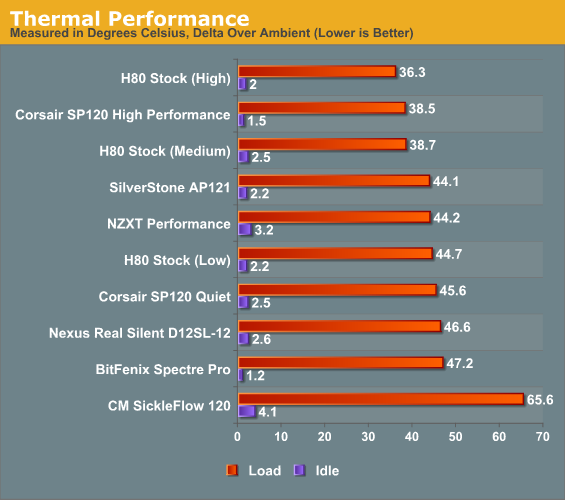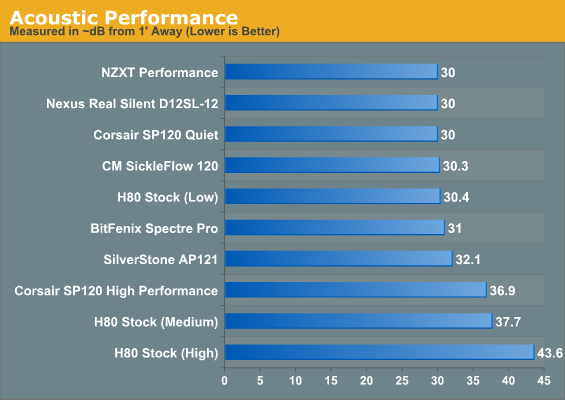Choosing the Best 120mm Radiator Fan: Testing Eight Fans with Corsair's H80
by Dustin Sklavos on August 23, 2012 12:01 AM ESTTest Results
Before we get into the performance results, a refresher: all eight fans on one chart for comparison. Note that if we're not taking noise into account, the highest static pressure fan should theoretically be the best performer. Our H80's fan settings are also only active with the stock fan; all others run at the full twelve volts.
| Fan | Airflow (in CFM) | Static Pressure (in mm/H2O) | RPM | Rated dBA |
| H80 Stock | 46-92 | 1.6-7.7 | 1300-2500 | 22-39 |
| SP120 Quiet |
37.85 |
1.29 | 1450 | 23 |
| SP120 High Performance | 62.74 | 3.1 | 2350 | 35 |
| SilverStone AP121 | 35.36 | 1.71 | 1500 | 22.4 |
| BitFenix Spectre Pro | 56.22 | 1.24 | 1200 | 18.9 |
| Nexus Real Silent D12SL-12 | 36.87 | 1.2 | 1000 | 18 |
| CoolerMaster SickleFlow 120 | 69.69 | 2.94 | 2000 | 19 |
| NZXT Performance | 47.27 | 0.95 | 1300 | 25.35 |
As far as static pressure goes, most of these fans are hanging out in about the same neighborhood. Acoustically, only Corsair's SP120 High Performance and stock H80 fan are even rated to go above the noise floor of our sound meter, though it's clear the stock fan is designed to move heat as fast as humanly possible. Let's see how all of these theoreticals worked out in practice, though.
Ambient temperatures ranged between 24C and 26C, and the margin for error in results is roughly 1C.

Thermally, if we ignore the H80's stock fan, the SickleFlow should've eaten the competition alive, but as it turns out CoolerMaster's specifications were more than just a little optimistic, as it was hands down the worst radiator fan we tested by a wide margin. If we organize the fans by rated static air pressure, they'd rank from best to worst: SP120 High Performance, SickleFlow 120, SilverStone AP121, SP120 Quiet, BitFenix Spectre Pro, Nexus Real Silent, and dead last, the NZXT Performance. As it turns out, though, only the SP120 High Performance really performs in line with its specifications; the rest just bunch up while the SickleFlow 120 is clearly the worst.
So how about acoustic performance?

Well, at least CoolerMaster's fan is quiet while it cooks your processor. To get that great thermal performance from the SP120 and H80 stock fan, though, you're going to have to put up with some noise. Note that these are load noise readings; the H80 stock fan idles at or below our sound meter's 30dB threshold at Low and Medium settings while sitting at 34.3 dB at High.
Interestingly enough, despite having among the worst rated specs, NZXT's Performance fan seems to find the best balance between thermal performance and acoustics; Corsair's SP120 Quiet does little to justify itself over the stock H80 fan. Corsair's engineers also turned out to be mostly right on the money: the H80 stock fan by and large seems to be the best choice, at least for the H80 itself. Its Low setting is competitive with the other fans both thermally and acoustically, while its Medium setting is competitive with the SP120 High Performance fan. The High setting is essentially unnecessary.










113 Comments
View All Comments
Streetwind - Thursday, August 23, 2012 - link
Yes, as far as I'm aware it's based on the Fan Xpert II software that's bundled with the Panther Point boards; it doesn't work directly from the UEFI.In fact, didn't Anand post a video earlier the year where an ASUS rep came over to you guys show off the fan control software in action?
maximumGPU - Thursday, August 23, 2012 - link
Yes they do, i have 7x Asus board and their fan control software is superb. it'll work with both PWM and non-PWM fans as in my case.It provides a lot of useful information too such as min and max rpm for each fan.
the only thing missing is the ability to create a fan profile that could be linked to temperature other than cpu temp, like motherboard for example.
Their software is what pushed me to chose their mobo instead of competitors.
Iketh - Thursday, August 23, 2012 - link
oh come on, they are not rare at alldanjw - Thursday, August 23, 2012 - link
Yes, I believe that the Z7x's can also voltage control. But PWM usually have a better range then with standard fans, voltage controlled. Also, I believe the Corsair Link controller does voltage control as well.ckevin1 - Thursday, August 23, 2012 - link
I have an Asus P8Z68-V Gen3, and last night I went through the pain of figuring out how to voltage control a 3-pin fan on it. It *can* be done.The CPU and SYS fan headers are PWM only, as I found, but the 4-pin Chassis fan header (near the slots & I/O panel) does support voltage control. Plain old fan XPert that they provide on the download site for my board can control it, and it can also be set up from the BIOS.
piroroadkill - Thursday, August 23, 2012 - link
You say this, but I had an MSI board back in the Pentium III era that had completely independant fan control on all headers.I also had an Abit board with µguru that had completely independant fan header control, for Pentium 4.
I also had an Abit board with µguru that had total control for Socket 775...
Now I have an Asus P8Z68-V Pro, and before I had another 775 Asus board, I've never had worse fan control. The headers are shared, each are a certain type of control.. It's pathetic.
In summary: abit had amazing fan control for many years, Asus is playing catch up, your comment is therefore amusing.
piroroadkill - Thursday, August 23, 2012 - link
Oh, and I wish I could edit, but I can't forget that the ASUS boards also prevent you from dropping the speed below a certain amount, which is awful. I had to fit resistors to my Corsair A70 and THEN fan control it to make it a reasonable noise level. I'd prefer to have the full range of speed available to me.ypsylon - Thursday, August 23, 2012 - link
InstaFAIL. By far most potent fans on the market. They combine supreme performance (120mm - 138.4m3=82CFM @ 1500rpm/26dB) with low noise and great price for performance. Running exclusively only AC Sharks now. Tested many fans, survived only 1 type.For liquid cooling solutions (even for such poor AIO kits) there is easy way to improve cooling a bit. Put spacer (gutted old fan or buy brand new one in shops trading LC things) between radiator and fan(s) on the intake side. That way radiator will be cooled equally on the entire surface. With default setup: fan straight to radiator, center of radiator is warmer than edges, simply because air straight below fan bearing cannot cool and move quickly enough.
Stupido - Thursday, August 23, 2012 - link
The idea of the spacer is an excellent one!Thanks for that!
JerWA - Thursday, August 23, 2012 - link
Any hopes of you guys snagging one of these to add to the test results?Gelid Wing 12 PL, P/N: FN-FW12BPL-18.
http://www.gelidsolutions.com/products/index.php?l...
I'm using 2 as the push in a push/pull H100 setup, and it'd be nice to know if there's a better option and just how they measure up in comparison.